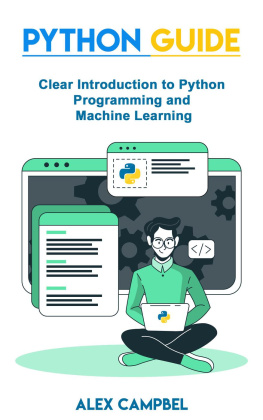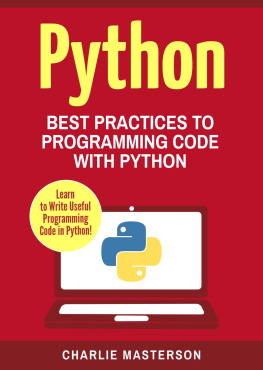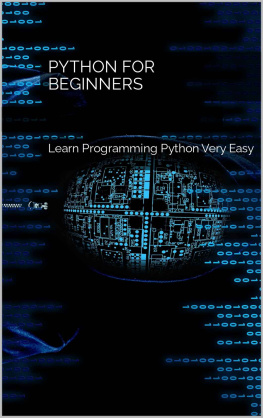Python for Beginners
A Crash Course Guide to Learn Python in 1 Week
By Timothy C. Needham
Copyright 2019 - All Rights Reserved Timothy C. Needham
ALL RIGHTS RESERVED. No part of this publication may be reproduced or transmitted in any form whatsoever, electronic, or mechanical, including photocopying, recording, or by any informational storage or retrieval system without express written, dated and signed permission from the author.
Table of Contents
Other Books By Lito Publishing
Introduction
Thank you for downloading this book.
The book has lots of actionable information that will get you started on the journey to becoming a pro at python programming.
Without doubt, code is the language of the future. Think about it, with the ever growing dependency on computers, one of the most critical things that anyone in the world today can learn is how to speak to computers in a language that they understand and have them do anything that you want to do. This skill is one whose demand is increasing at an increasing rate the world over. Whether you want to learn code to pursue a career as a programmer, web developer or graphics designer or want to learn code to be able to develop your own web applications and other computerized systems, the one thing you need to do is to start somewhere. What better place to start than to learn python?
Python is a simple yet powerful programming language that can enable you to start thinking like a programmer right from the beginning. It is very readable and the stress many beginners face about memorizing arcane syntax typically presented by other programming languages will not affect you at all. Conversely, you will be able to concentrate on learning concepts and paradigms of programming.
This book shall introduce you to an easy way to learn Python in just 7 days and in this time, be able to complete your own projects! By reading the book and implementing what you learn herein, you will realize just why major institutions like NASA, Google, Mozilla, Yahoo, Dropbox, IBM, Facebook and many others prefer to use python in their core products, services and business processes. Lets begin.
Thanks again for downloading this book. I hope you enjoy it!
Before we can get to a point of learning the ins and outs of python programming, lets start by building an understanding of what python programming is and what it is about.
Download the Audiobook version of this book for free!
If you love listening to audiobook while youre in the car or working out, Ive a great news for you! You can download the audiobook version of this book for FREE by just signing up for FREE 30-Day Audible Trial!
Click The Link Below to Get Started!
For Audible US
For Audible UK
For Audible Fr
For Audible DE
Chapter 1: Python: A Comprehensive Background
Before we discuss Python programming, especially what python is, let me briefly say something about programming.
Being a good programmer does not simply entail just knowing a vast array of programming languages or how to code fast programs. Instead, it is about:
Comprehending a problem abstractly and being able to change it into code.
Looking for new ways to tackle, for instance, a scientific problem and knowing the kind of tools to use.
Being able to fix a program when it is not working
Writing a program that is quick enough, not the quickest possible
Writing a program that other people can understand in a short period of time
Take note of the last point: Reproducible research and open science is becoming the norm in some research fields. This means that other people will probably have to read your code, understand exactly what you are doing and be able to recreate the code so that they can run it themselves.
By the end of this book therefore, we will not only be interested in the correctness of your solutions; we shall also look at whether we can understand how the program you create solves the problem.
This is to mean that y ou should always write your codes assuming that someone else will read it.
Lets go back to understanding python, the programming language of the future.
What Is Python?
In its simplest terms, python is a general-purpose, multi-paradigm, and interpreted programming language that gives programmers the ability to use various styles of programming to create complex or simple programs, get results faster, and write code in a way that resembles human language (explanation below).
Python is the programming language often used to create algorithms for sorting and analyzing chunks of data that businesses and organizations from all over the world collect.
The explanation above brings about some very interesting points about python:
Its a high level language
Python is a high-level language. This means the code you type to build a program is more like a human language than the typical code created to control machines. This, for one, makes things a lot simpler for you, the programmer, and means that someone else is better placed to understand the code if he/she wants to use it him/herself. The human-like (high-level) code then goes through a software called an interpreter that converts it into machine code, a language that machines can understand.
Its open source
The software that lets us make programs in Python is open source. This means it is available in the public domain and anyone can freely use it. The greatest advantage of this software is the fact that you can modify it and create your own version to perform particular tasks. This is actually the main reason why many people have openly embraced the open source concept and the use of python is no exception.
Lets discuss this briefly:
Associations that Use Python
Many organizations currently use Python to complete major tasks. You will not always hear about their uses since organizations are somewhat reserved about sharing their systems information, or trade secrets. Nonetheless, Python is still there making a great difference in the way organizations function and many common systems and applications have settled for Python for their development. Some of them include YouTube, Google Search, BitTorrent, NASA, Eve Online, iRobot machines, Yahoo, Facebook, Maya and many others.
Look at the following commercial uses of Python:
Corel: Over the years, people have used products such as PaintShop Pro to grab screenshots, modify pictures, draw fresh images, and perform many other graphic oriented tasks. What is amazing about this popular product is that it heavily relies on Python scripting. This means to automate tasks in PaintShop Pro, you will need a degree of Python knowledge.
D-link: It can be quite problematic to upgrade firmware over a network connection, and this company (D-link) encountered a situation where every upgrade tended to tie up a machine, something they described as a weak utilization of resources. Additionally, a number of upgrades needed extra work since there were problems with the targeted device.
The use of python to build a multi-threaded application that allows for the movement of updates to the devices enables one machine to service several devices, and a new methodology supported by python decreases all the reboots to one, after the installation of that fresh firmware is done.







